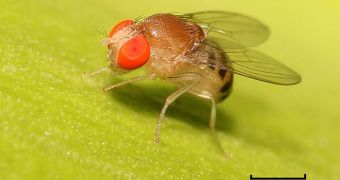Though many scientists would rather not discuss such delicate subjects, mate selection and reproduction is a very important part of understanding the evolution of species. Due to the gags imposed by religious fanatics, many universities and research institutes would rather not discuss such issues, in hope of avoiding controversy. But fortunately there are still those who move past these limitations, and conduct meaningful research. Such was the case with researchers at the Syracuse University, who conducted experiments on fruit fly and their mating preferences.
In order to gain additional insight into the very beginning of life in this species, the researchers here applied genetic engineering to the sperm in fruit flies, making it glow in the dark. This achievement is bound to provide them with additional knowledge of how these cells compete with one another when inside a female. Such studies could finally reveal which traits are responsible for making certain cells of this type prevail over the others. The results would have meaning when translated to our species as well, researchers say.
In humans, mating behavior and social norms preclude women from being with two or more men during the time of the month when they are most fertile. But female fruit flies have no such restraints, and they mate with several males during the same day. However, determining which cell belonging to which male won the “competition” and why proved to be extremely difficult to establish. But now, thanks to the new development, the Syracuse team can “tag” only certain cells, using a specialized fluorescent protein.
“It was simply thought of as 'this army of sperm competing,' so it functioned as a raffle; the more tickets you bought, the more sperm you transferred, the more likely you were to win out in that competition. Females were perceived as these passive vessels in which this competition played out--that females didn't play an active role. That's really not the case,” Syracuse University biology professor Scott Pitnick explains. The work was conducted under a grant money from the US National Science Foundation (NSF).
“The morphological diversity in insect sperm is off the charts. There are insect sperm that, you look at them and you would have no idea that you are even looking at a sperm cell. They look like more complex, free-living organisms. They're completely bizarre and interesting,” Syracuse postdoctoral researcher Mollie Manier concludes.

 14 DAY TRIAL //
14 DAY TRIAL //